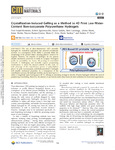Mostrar o rexistro simple do ítem
Crystallization-Induced Gelling as a Method to 4D Print Low-Water-Content Non-isocyanate Polyurethane Hydrogels
| dc.contributor.author | Fanjul-Mosteirín, Noé | |
| dc.contributor.author | Aguirresarobe, Robert | |
| dc.contributor.author | Sadaba, Naroa | |
| dc.contributor.author | Larrañaga, Aitor | |
| dc.contributor.author | Marín, Edurne | |
| dc.contributor.author | Martín, Jaime | |
| dc.contributor.author | Ramos-Gómez, Nicolás | |
| dc.contributor.author | Arno, Maria Chiara | |
| dc.date.accessioned | 2022-01-12T08:33:09Z | |
| dc.date.available | 2022-01-12T08:33:09Z | |
| dc.date.issued | 2021 | |
| dc.identifier.citation | Fanjul-Mosteirín, N.; Aguirresarobe, R.; Sadaba, N.; Larrañaga, A.; Marin, E.; Martin, J.; Ramos-Gomez, N.; Arno, M. C.; Sardon, H.; Dove, A. P. Crystallization-Induced Gelling as a Method to 4D Print Low-Water-Content Non-Isocyanate Polyurethane Hydrogels. Chem. Mater. 2021, 33 (18), 7194–7202. https://doi.org/10.1021/acs.chemmater.1c00913. | es_ES |
| dc.identifier.issn | 0897-4756 | |
| dc.identifier.issn | 1520-5002 | |
| dc.identifier.uri | http://hdl.handle.net/2183/29359 | |
| dc.description.abstract | [Abstract] The use of three-dimensional (3D) printable hydrogels for biomedical applications has attracted considerable attention as a consequence of the ability to precisely define the morphology of the printed object, allowing patients’ needs to be targeted. However, the majority of hydrogels do not possess suitable mechanical properties to fulfill an adequate rheological profile for printability, and hence, 3D printing of cross-linked networks is challenging and normally requires postprinting modifications to obtain the desired scaffolds. In this work, we took advantage of the crystallization process of poly(ethylene glycol) to print non-isocyanate poly(hydroxyurethane) hydrogels with tunable mechanical properties. As a consequence of the crystallization process, the hydrogel modulus can be tuned up to 3 orders of magnitude upon heating up to 40 °C, offering an interesting strategy to directly 3D-print hydrogels without the need of postprinting cross-linking. Moreover, the absence of any toxicity makes these materials ideal candidates for biomedical applications. | es_ES |
| dc.description.sponsorship | The authors acknowledge financial support from the European Commission through SUSPOL-EJD 642671 project. M.C.A. thanks the University of Birmingham for funding | |
| dc.language.iso | eng | es_ES |
| dc.publisher | American Chemical Society | es_ES |
| dc.relation | info:eu-repo/grantAgreement/EC/H2020/642671 | es_ES |
| dc.relation.uri | https://doi.org/10.1021/acs.chemmater.1c00913 | es_ES |
| dc.rights | Attribution 4.0 International (CC BY 4.0) | es_ES |
| dc.rights.uri | https://creativecommons.org/licenses/by/4.0/ | * |
| dc.subject | Crystallization | es_ES |
| dc.subject | 3D printing | es_ES |
| dc.subject | Inorganic carbon compounds | es_ES |
| dc.subject | Hydrogels | es_ES |
| dc.subject | Materials | es_ES |
| dc.title | Crystallization-Induced Gelling as a Method to 4D Print Low-Water-Content Non-isocyanate Polyurethane Hydrogels | es_ES |
| dc.type | info:eu-repo/semantics/article | es_ES |
| dc.rights.access | info:eu-repo/semantics/openAccess | es_ES |
| UDC.journalTitle | Chemistry of Materials | es_ES |
| UDC.volume | 33 | es_ES |
| UDC.issue | 18 | es_ES |
| UDC.startPage | 7194 | es_ES |
| UDC.endPage | 7202 | es_ES |
| dc.identifier.doi | 10.1021/acs.chemmater.1c00913 |
Ficheiros no ítem
Este ítem aparece na(s) seguinte(s) colección(s)
-
GI-Polímeros - Artigos [29]
-
OpenAIRE [341]






